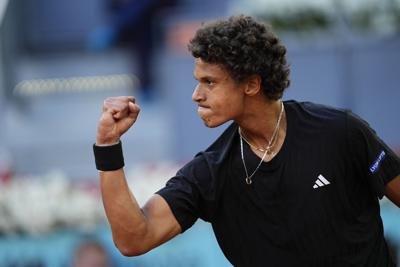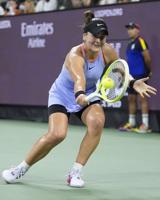Gabriel Diallo jumped up 40 spots in the ATP rankings. Then he jumped up 31 spots. Then he jumped up 34 spots.
That’s a quickie tour of the Montrealer’s ascent of the tennis ladder over the past year.
Precisely 12 months ago, Diallo made his Grand Slam debut at Roland Garros ranked 166th. Had to grind through qualifiers, winning a trio of three-set matches to squeeze into the main draw, where he fell in the second round.
When the French Open launches on Sunday, the 23-year-old will hurtle out of the blocks ranked a career-high No. 53.
That’s a remarkable upthrust for a near fledgling who only turned pro in 2023.
How he came full circle: two more major debuts — U.S. Open (reached the third round) and Australian Open (second round) — first tour-level final, ATP 250 event in Almaty, Kazakhstan; first Masters 1000 quarterfinal (major breakthrough) at the Madrid Open last month.
In Paris — ranked behind Denis Shapovalov (seeded 27th) and Félix Auger-Aliassime (29³Ù³ó)Ìý— Diallo will open against No. 18 seed Francisco Cerundolo.
“Obviously for me it’s a special slam,’’ says Diablo of the iconic red-clay major that Rafael Nadal dominated across two decades. “The first time I made the draw there was a very special moment for me. But last year was last year. I was kind of dipping my toe in the water, adjusting to playing in a slam, playing on a big court against a big name. Everything was kind of new.’’
Lost in five sets to 2014 U.S. Open finalist Kei Nishikori.
“I feel my little backpack of experience has gotten bigger, so I’m going to be much better prepared as well.’’
With Flushing Meadows and Melbourne under his belt, too, slams are more than a smidge less nerve-rattling, even as projections escalate: “The expectation that I put on myself is different from last year, even though it’s on clay, which is not the surface that I grew up on. But I still expect myself to try and achieve good things on it. Everything is in place for me to perform.’’
Boosting Diallo’s confidence is that he’s played more clay matches this season than any other Canadian on the European leg of the tour, with a 7-3 record and the biggest win of his career by defeating Grigor Dimitrov in Madrid in the fourth round.
The sweltering environment in Spain suited the six-foot-eight Diallo, who’s athletically agile for his height: “The altitude, the hot weather, the same amount of clay that there is on court makes the conditions really fast, which I really enjoy. That played really well behind my serve.’’
His self-assurance has grown exponentially: “That helps with the belief, for sure, because you never know how it feels until you accomplish something. For me, it was so far away to reach the quarterfinals of a major until it’s done. And then you’re like: If I made it, where else can I go? How far can I go?’’
To that end, he now travels almost full-time with a physiotherapist in his posse: “I’m trying to do everything by the book. We have the mentality of (being) more process-oriented.’’
Of course, unlike most sports, players have to pay the entourage out of their own pocket: physiotherapist, coach, travel expenses. Diallo can afford it now. Year to date, he’s earned some $462,400 (U.S.), nearly $1,341,700 in his nascent career. Hey, it’s a living. For someone in their early 20s.
While he’s outranked by his Canadian compatriots in Paris, he’s not bringing any baggage, either, no crushing failures against inferior opponents.
“The ranking in slams doesn’t really matter until maybe you’re in top 32 and you get a seed. But even then I feel like the level is so deep, you’ve got guys that are not seeded that I promise you I don’t want to see them in the draw.’’
Paris a year ago and what’s unfolded since has shown he can gallop with some of the fastest horses: “This is going to help me with the belief that I can do some damage at that level.’’
Roland Garros is tricky. World No. 1 Jannik Sinner has never claimed the crown, losing in five sets last year to Carlos Alcaraz in the semifinals. Alcaraz, the defending champion and seeded second, polished off the Italian 7-6, 6-1 at the Rome Open earlier this month. It was Sinner’s first match after a three-month doping ban. But it ended Sinner’s 26-match winning streak, going back to last season.
Slam hard-luck Alexander Zverev — he has yet to win any — is seeded third. He was runner-up in 2024 and made the Australian Open final in January, erased by Sinner in straight sets.
And of course there’s Novak Djokovic, at age 38 still bidding to become the first player to rack up 25 Grand Slam titles. The Serb pulled out midway through last year’s French Open after tearing the meniscus in his right knee. He’s thrice walked off with the trophy at Roland Garros, mostly recently in 2023. But he pulls into Stade Roland Garros seeded sixth with a tough draw.
Arguably the greatest men’s tennis player of all time, Djokovic lost in the opening set in Madrid, Monte Carlo and Miami before rebounding to reach Saturday’s Geneva Open final. Following his loss in Madrid, Djokovic spoke about an unsettling new reality.
“It’s a completely different feeling from what I had in 20-plus years of professional tennis. It’s a challenge for me mentally to really face these kinds of sensations on the court, going out early now regularly in tournaments.’’
Some come, some go.


































To join the conversation set a first and last name in your user profile.
Sign in or register for free to join the Conversation